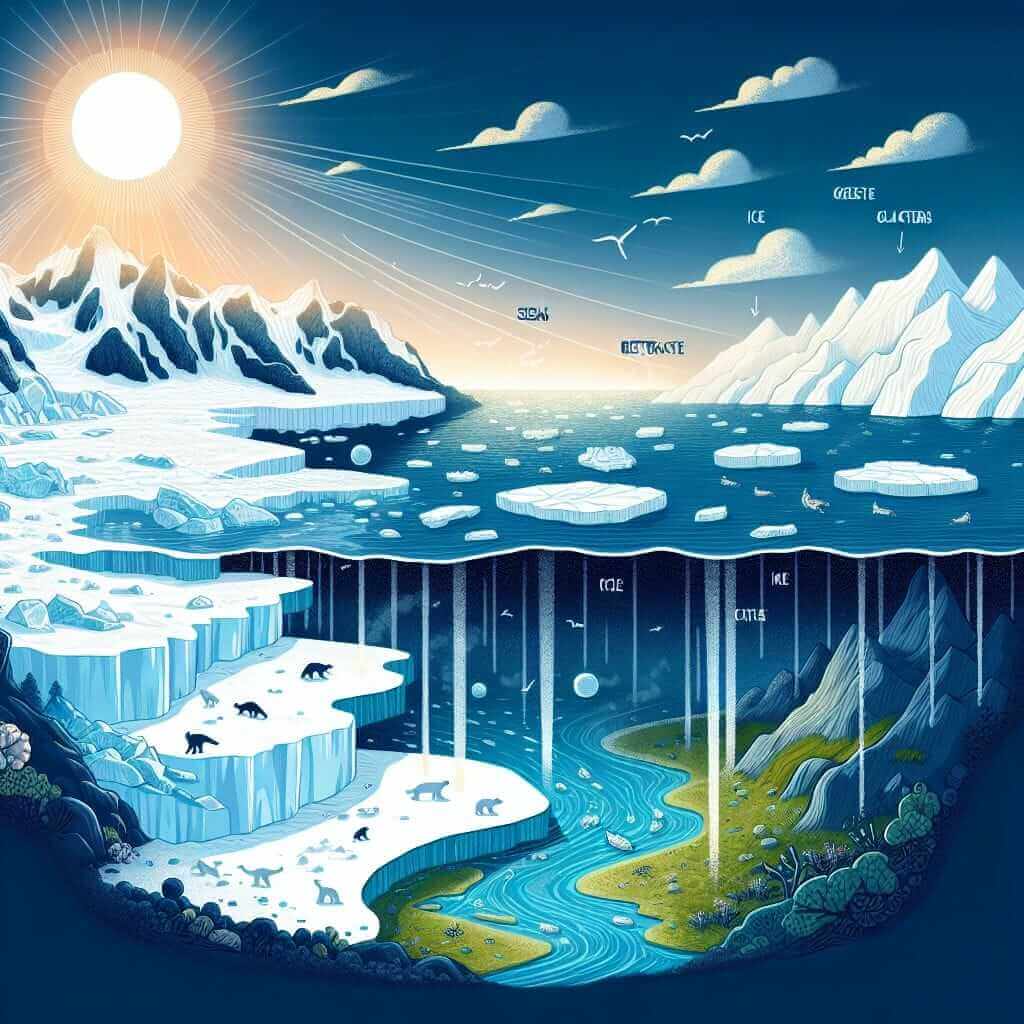Global warming, a phenomenon caused predominantly by human activities, has significantly impacted the polar ice caps. This issue frequently appears in IELTS Writing Task 2, with various facets being examined in different essay prompts. Understanding the implications of global warming on the polar ice caps is essential for IELTS candidates, not only for answering effectively but also for building informed arguments in their essays.
Nội dung bài viết
Related Essay Prompts:
- “Discuss the effects of global warming on the polar ice caps and suggest possible solutions to mitigate these effects.”
- “What are the consequences of the melting polar ice caps on global sea levels and ecosystems?”
- “To what extent do you agree that human activities are responsible for the melting of polar ice caps? Justify your answer with relevant examples.”
Main Content
Choosing a Prompt
For this guide, we will focus on the first prompt: “Discuss the effects of global warming on the polar ice caps and suggest possible solutions to mitigate these effects.”
Analyzing the Prompt
Before diving into the essay, it is crucial to break down the prompt:
- Task Requirements: The essay requires you to cover two aspects – the effects of global warming on the polar ice caps and the possible solutions to mitigate these effects.
- Keywords: Effects, global warming, polar ice caps, solutions, mitigate.
- Structure: Introduction, effects of global warming on polar ice caps, solutions to mitigate the effects, conclusion.
Sample Essay
Global warming has emerged as one of the most pressing environmental challenges of our time, profoundly affecting the polar ice caps. The ramifications of this phenomenon are severe, leading to rising sea levels, disrupted ecosystems, and a host of other global issues. This essay will discuss these effects in greater detail and propose viable solutions to mitigate the impacts of global warming on polar ice caps.
The melting of polar ice caps is a direct consequence of increasing global temperatures. As the Earth’s climate warms, the ice sheets in the Arctic and Antarctic regions begin to thaw, resulting in significant ice loss. According to recent studies, the Arctic ice is melting at an alarming rate, leading to a rise in sea levels. This increase poses a substantial threat to coastal communities, resulting in more frequent and severe flooding, erosion of shorelines, and loss of habitat for both humans and wildlife.
Furthermore, the melting ice caps contribute to the disruption of marine ecosystems. Polar regions are home to a diverse range of species, including polar bears, seals, and penguins, which rely on ice for their survival. As the ice diminishes, these species face habitat loss and dwindling food sources, pushing them toward extinction. The imbalance in the ecosystem resulting from the loss of such species can have cascading effects on the global food chain, affecting biodiversity and negatively impacting human livelihoods dependent on marine resources.
To address these dire consequences, it is crucial to adopt and implement effective solutions. One primary approach is to reduce greenhouse gas emissions, which are the leading cause of global warming. This can be achieved by transitioning to renewable energy sources, such as wind, solar, and hydroelectric power, which produce little to no carbon emissions. Additionally, enhancing energy efficiency in industries, homes, and transportation can significantly lower the carbon footprint, thereby slowing down global warming.
Another vital solution is to implement policies and regulations that protect and restore polar habitats. Governments and international organizations should collaborate to establish protected areas in polar regions, restricting activities such as oil drilling and commercial fishing that further exacerbate the degradation of these fragile environments. Investing in research and technology to develop innovative methods for carbon capture and storage can also play a critical role in mitigating the effects of global warming.
In conclusion, the impact of global warming on polar ice caps is a multifaceted challenge that demands immediate attention and action. The melting of ice caps leads to rising sea levels and disrupted ecosystems, with far-reaching consequences for both the environment and human societies. By reducing greenhouse gas emissions and implementing protective policies, we can mitigate these effects and preserve polar regions for future generations.
(Word count: 432)
Writing Tips
- Vocabulary: Use a range of vocabulary to discuss environmental issues (e.g., “thaw,” “dwindling,” “cascading effects”).
- Grammatical Range and Accuracy: Ensure the use of a mix of tenses and complex sentence structures to demonstrate grammatical proficiency.
- Coherence and Cohesion: Subsequently connect ideas using appropriate linking words and phrases.
Key Vocabulary
- Thaw (Verb) /θɔː/: To melt or cause to melt from a solid frozen state to liquid.
- Dwindling (Adjective) /ˈdwɪndlɪŋ/: Gradually diminishing in size, amount, or strength.
- Cascading effects (Noun phrase): A series of events triggered by an initial event, leading to subsequent and typically unintended consequences.
- Carbon footprint (Noun) /ˈkɑː.bən ˈfʊt.prɪnt/: The total amount of greenhouse gases produced directly and indirectly by human activities.
- Transition (Verb) /trænˈzɪʃən/: To change from one state, form, activity, or place to another.

Conclusion
In summary, global warming’s impact on the polar ice caps is a critical topic often seen in IELTS Writing Task 2. Understanding and articulating the effects and potential solutions are key to crafting a compelling essay. For further practice, consider writing about:
- “How does global warming affect polar wildlife?”
- “Evaluate the role of international policies in combating the melting of polar ice caps.”
Continuously practicing such essay topics will not only enhance your awareness of pressing environmental issues but also improve your IELTS writing skills.